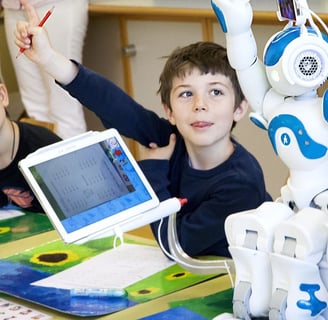Unleashing Creativity and Learning with Robotics in Education
Exploring the role of robotics in education, including its benefits for students, popular robotics programs for children, and how robotics enhances STEM learning.
Vinay
4/10/20245 min read


Introduction:
Robotics has emerged as a powerful tool in education, revolutionizing the way students learn and engage with STEM subjects. In this blog post, we'll delve into the transformative role of robotics in education, exploring its benefits for students, highlighting popular robotics programs for children, and discussing how robotics enhances STEM learning.
Benefits of Robotics in Education:
Hands-On Learning: Robotics provides students with hands-on learning experiences, allowing them to design, build, and program robots to solve real-world problems. This hands-on approach fosters creativity, critical thinking, and problem-solving skills.
2. Interdisciplinary Learning: Robotics integrates concepts from various STEM disciplines, including mathematics, engineering, computer science, and physics. By engaging with robotics, students develop a holistic understanding of these subjects and learn how they intersect in practical applications.
Active Engagement: Robotics projects actively engage students in the learning process, sparking curiosity and enthusiasm for STEM subjects. Students become active participants in their education, driving their own learning through experimentation, collaboration, and exploration.
Real-World Relevance: Robotics projects often simulate real-world scenarios and challenges, making learning more relevant and meaningful for students. Whether designing a robot to navigate a maze or programming a robot to perform specific tasks, students see the direct application of their learning in solving tangible problems.
Future-Ready Skills: Robotics equips students with essential 21st-century skills, such as computational thinking, teamwork, communication, and adaptability. These skills are invaluable for success in an increasingly technology-driven world.
Enhancing STEM Learning with Robotics:
Project-Based Learning: Robotics projects promote project-based learning, where students work collaboratively to identify problems, design solutions, and iterate on their designs. This approach encourages students to take ownership of their learning and fosters a deeper understanding of STEM concepts.
Cross-Curricular Integration: Robotics integrates seamlessly with various STEM subjects, providing opportunities for cross-curricular learning. For example, students may apply mathematical concepts such as geometry and algebra to calculate robot movements or explore physics principles such as friction and force in robot design.
Computational Thinking: Robotics introduces students to computational thinking, a problem-solving process that involves breaking down complex problems into smaller, more manageable tasks. Through coding and programming robots, students develop computational thinking skills, including algorithmic design, pattern recognition, and debugging.
Career Exploration: Robotics exposes students to potential career paths in STEM fields, inspiring them to pursue further education and careers in areas such as robotics engineering, computer science, and mechatronics. By engaging with robotics, students gain valuable insights into STEM professions and the skills required to succeed in these fields.
Popular Robotics Program for Children:
The Mumbai Coding Lab: designed for students of different age groups. These hands-on robotics kits introduce students to robotics and coding concepts in a fun and accessible way, promoting creativity and experimentation.
The most important thing parents should look for while searching for robotics and coding schools is physical accessible distance and flexibility of physical one-to-one and online/virtual classes. At TMCL we are happy to offer both Physical one-to-one and Online classes as they prefer. Our Lab is located in Velentine Apartment Building in Malad East near Oberoi Mall.
Website Link: https://themumbaicodinglab.in/
The most important factor while choosing any after-school program like robotics and coding is affordability, the TMCL programs are easily affordable to anyone.
Conclusion:
In conclusion, robotics plays a pivotal role in education by providing students with hands-on learning experiences, fostering interdisciplinary skills, and preparing them for future success in STEM-related fields. By integrating robotics into educational curricula and programs, educators empower students to become creative problem solvers, critical thinkers, and lifelong learners in an increasingly technology-driven world.


Introduction:
Robotics has emerged as a powerful tool in education, revolutionizing the way students learn and engage with STEM subjects. In this blog post, we'll delve into the transformative role of robotics in education, exploring its benefits for students, highlighting popular robotics programs for children, and discussing how robotics enhances STEM learning.
Benefits of Robotics in Education:
Hands-On Learning: Robotics provides students with hands-on learning experiences, allowing them to design, build, and program robots to solve real-world problems. This hands-on approach fosters creativity, critical thinking, and problem-solving skills.
2. Interdisciplinary Learning: Robotics integrates concepts from various STEM disciplines, including mathematics, engineering, computer science, and physics. By engaging with robotics, students develop a holistic understanding of these subjects and learn how they intersect in practical applications.
Active Engagement: Robotics projects actively engage students in the learning process, sparking curiosity and enthusiasm for STEM subjects. Students become active participants in their education, driving their own learning through experimentation, collaboration, and exploration.
Real-World Relevance: Robotics projects often simulate real-world scenarios and challenges, making learning more relevant and meaningful for students. Whether designing a robot to navigate a maze or programming a robot to perform specific tasks, students see the direct application of their learning in solving tangible problems.
Future-Ready Skills: Robotics equips students with essential 21st-century skills, such as computational thinking, teamwork, communication, and adaptability. These skills are invaluable for success in an increasingly technology-driven world.
Enhancing STEM Learning with Robotics:
Project-Based Learning: Robotics projects promote project-based learning, where students work collaboratively to identify problems, design solutions, and iterate on their designs. This approach encourages students to take ownership of their learning and fosters a deeper understanding of STEM concepts.
Cross-Curricular Integration: Robotics integrates seamlessly with various STEM subjects, providing opportunities for cross-curricular learning. For example, students may apply mathematical concepts such as geometry and algebra to calculate robot movements or explore physics principles such as friction and force in robot design.
Computational Thinking: Robotics introduces students to computational thinking, a problem-solving process that involves breaking down complex problems into smaller, more manageable tasks. Through coding and programming robots, students develop computational thinking skills, including algorithmic design, pattern recognition, and debugging.
Career Exploration: Robotics exposes students to potential career paths in STEM fields, inspiring them to pursue further education and careers in areas such as robotics engineering, computer science, and mechatronics. By engaging with robotics, students gain valuable insights into STEM professions and the skills required to succeed in these fields.
Popular Robotics Program for Children:
The Mumbai Coding Lab: designed for students of different age groups. These hands-on robotics kits introduce students to robotics and coding concepts in a fun and accessible way, promoting creativity and experimentation.
The most important thing parents should look for while searching for robotics and coding schools is physical accessible distance and flexibility of physical one-to-one and online/virtual classes. At TMCL we are happy to offer both Physical one-to-one and Online classes as they prefer. Our Lab is located in Velentine Apartment Building in Malad East near Oberoi Mall.
Website Link: https://themumbaicodinglab.in/
The most important factor while choosing any after-school program like robotics and coding is affordability, the TMCL programs are easily affordable to anyone.
Conclusion:
In conclusion, robotics plays a pivotal role in education by providing students with hands-on learning experiences, fostering interdisciplinary skills, and preparing them for future success in STEM-related fields. By integrating robotics into educational curricula and programs, educators empower students to become creative problem solvers, critical thinkers, and lifelong learners in an increasingly technology-driven world.
